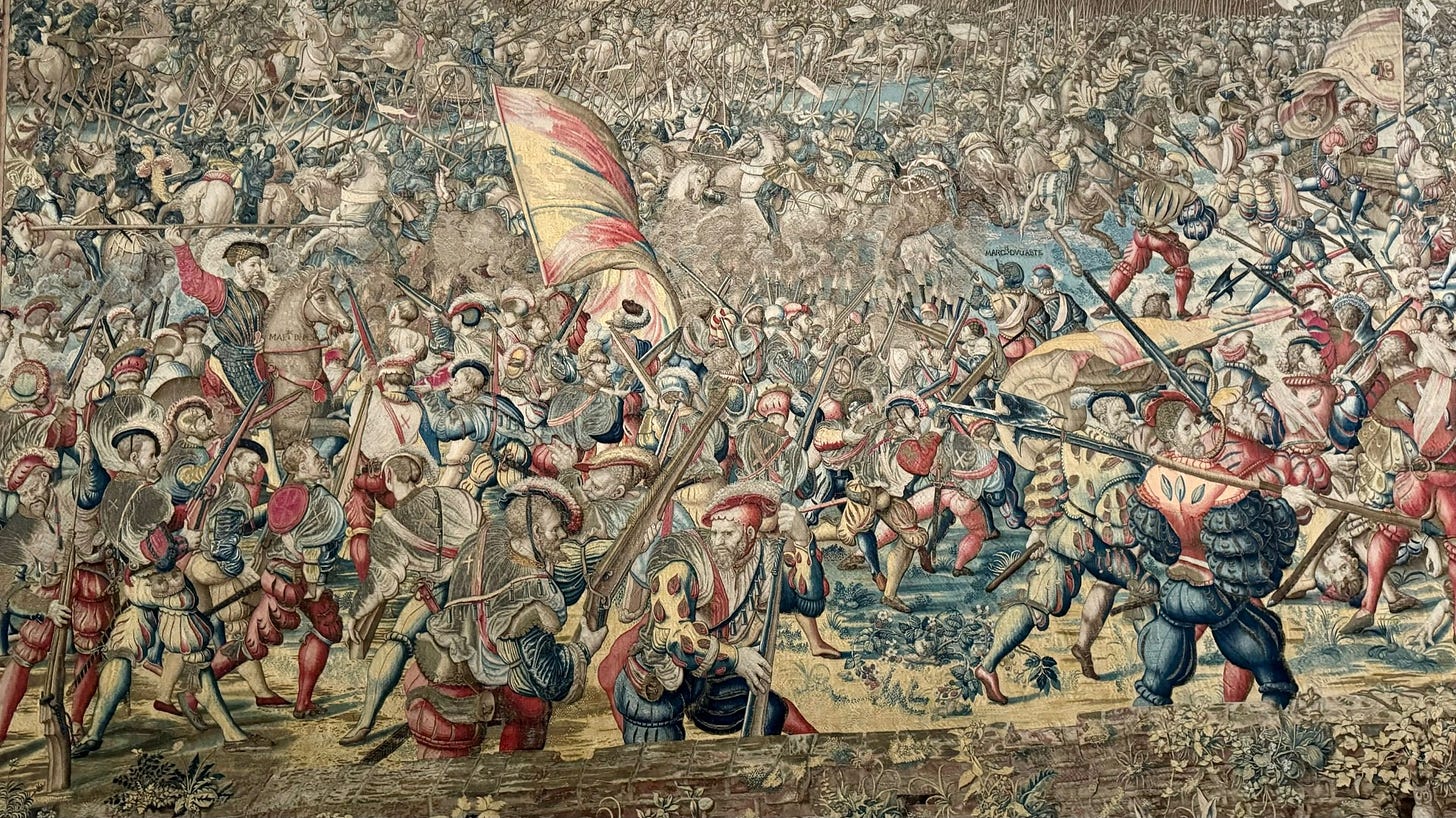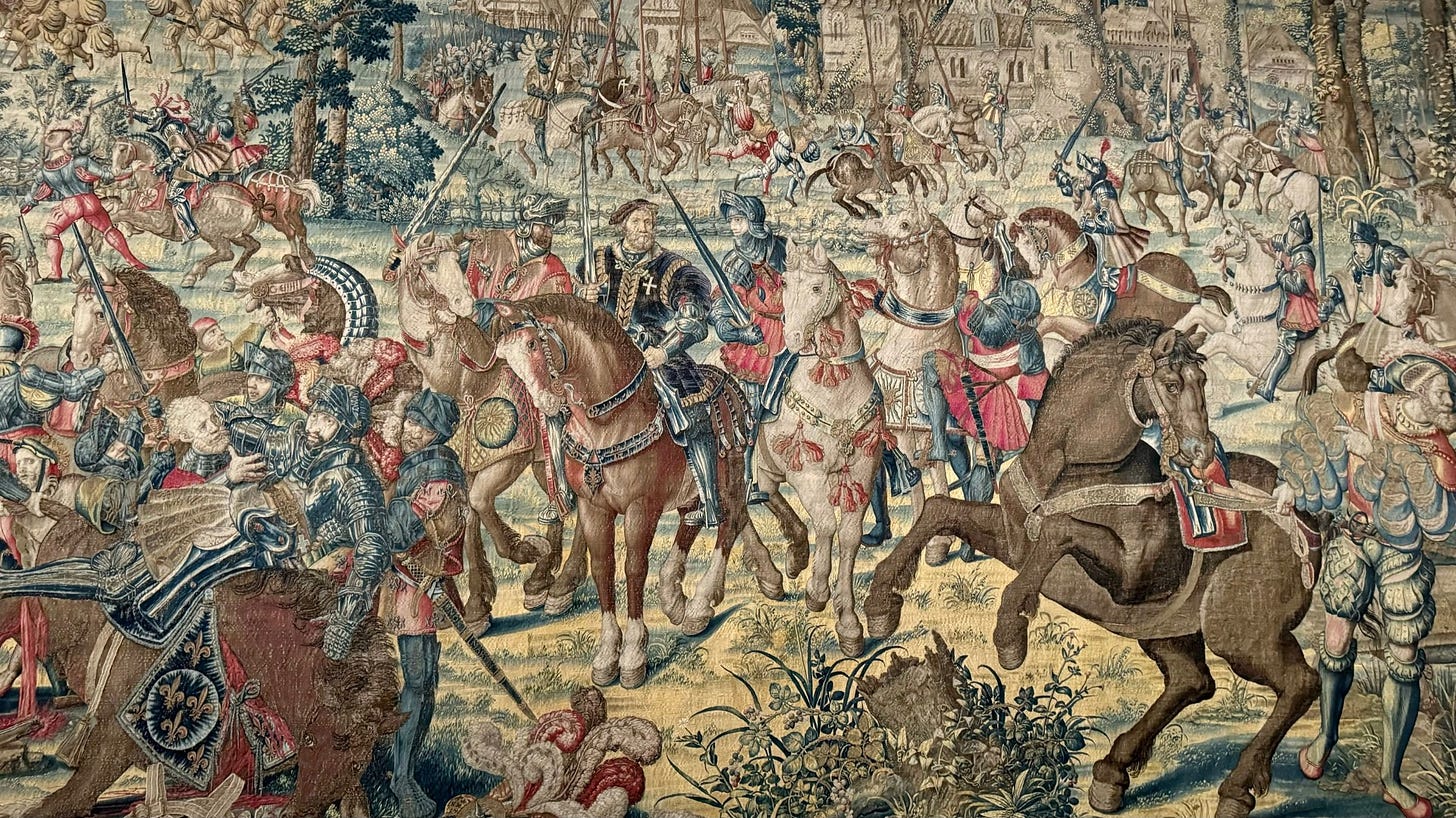A scene from the Pavia Tapestries — King Francis I leads French cavalry to counterattack the Imperial Army. King Francis is on the left with lifted visor.
I got a chance to see the Pavia Tapestries on tour at The Museum of Fine Arts, Houston. In looking at the tapestries displayed across the gallery, I had the realization that I was walking through the equivalent of a Renaissance IMAX movie.
The Pavia Tapestries, a collection of seven tapestries, depict a major battle between the Kingdom of France and the sprawling Habsburg Empire of Charles V.
Contesting control over northern Italy, the 1525 Battle of Pavia was part of the ongoing struggle between France and the Habsburg Empire (encompassing roughly modern-day Spain, Austria, the Low Countries, large parts of Italy, plus colonies in the Americas, and more).
The tapestries were commissioned to commemorate the Imperial victory.
On horseback, Fernando Francesco d’Avalos, Marquis of Pescara, leading formations of arquebusiers against the French.
Tapestries were immensely expensive — an art form reserved for nobility or wealthy mercantile families.
These seven tapestries are roughly thirty feet by sixteen feet although I’ve seen different numbers quoted as to the dimensions, suffice to say that all are not of uniform measurement.
Woven of wool, silk, gold, and silver, each tapestry weighs around one hundred pounds. Bernard van Orley masterminded the depictions across the tapestries, and over a period of three years the massive project took shape in the Brussels workshop of Willem and Jan Dermoyen.
I wonder how many people played a role in the preparation and construction process — dozens? Hundreds?
In viewing these tapestries, one may feel like it is a lot — too much — to take in at first glance. Allow yourself to be drawn in.
The tapestries are worth more than one look. There is an immersive and masterly crafted story waiting for you. There’s a great level of detail, even down to the facial expressions finely woven with shuttle and thread.
The tapestries depict actual events and historical personages, but there’s a worldbuilding element to them. I was struck by the connection between each weave in a tapestry and writing each word on the page — little by little shaping each character and the world as a whole.
With weaving and writing, there’s a need to keep focus in more than one place. Each word needs to be well chosen and well placed, but one needs not to lose sight of the overall vision.
The careful placement of depth and detail can also be a painstaking and tedious process. I wonder how much threading, unthreading, and rethreading took place within the Pavia Tapestries to get things just so.
And while there are similarities within the creative processes, compared to large numbers of weavers and assistants working on royal tapestries, writing (and by extension, worldbuilding) is usually a solitary activity.
For me, intricate details add to a story. It provides a way to understand the care and attention put into establishing and developing a new world. Yet, the details need to be balanced within the flow of the story.
That’s the reward for me — the challenge and adventure of writing an epic story, creating a new world. Getting things “just so” in the stories I want to tell. “Just so” will be a different definition for each writer, for each story, but there’s a creative intuition that lets us know when we’re close to the mark.
That feeling can come in many forms — nagging uncertainty as if something is missing or misplaced — all the way to blissful euphoria as each word falls neatly into place. These senses help us align the story to where it should be.
There’s the synergy of the constructive force (the time and effort) and the guiding force of inspiration that serves as a beacon on dark and stormy nights.
The vision and hard work by all involved in the Pavia Tapestries (and in the continual preservation work) are inspiring.
A showcase of fine art. A triumphant endeavor to tell a big story.
In the lower left corner, King Francis of France is helped from his wounded horse. In the press of battle, King Francis’ horse was wounded by an arquebus, the king trapped and unable to flee. He would be imprisoned in Spain until the signing of the Treaty of Madrid the following year.
Once freed and back in France, King Francis and his royal council determined that the treaty was not valid as it was signed while he was under duress in captivity. Conflict between King Francis and Emperor Charles (who was not present at Pavia) would soon renew.
Peace was fleeting, but the brilliant creation of the tapestries’ artisans is still with us.
Creative forces transcend time. I think that’s something we all want with the stories we’re telling.
Do you like strolling through museums? What works of art from centuries gone by inspire you? Share your thoughts in the comments.






